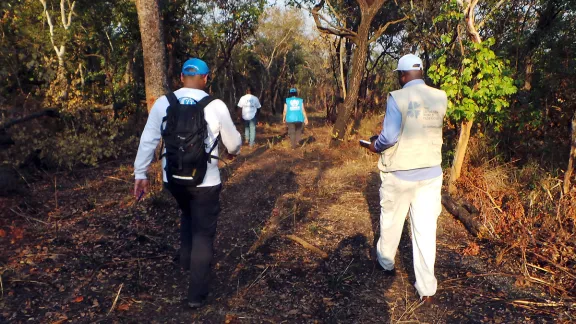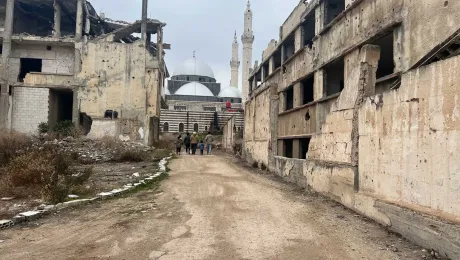
LWF and UNHCR staff survey a site designated for a new refugee camp in Lunda Norte province, northeastern Angola. Photo: LWF
LWF and UNHCR set up a new camp for people fleeing DRC
(LWI) - The Lutheran World Federation (LWF) and the United Nations High Commissioner for Refugees (UNHCR) are jointly striving to carve a living area out of dense Angolan bush for people displaced by inter-community tension in the Kasai region of the Democratic Republic of Congo (DRC).
A complex emergency is unfolding in Kasai due to inter-community tensions and clashes between militia groups, the Congolese armed forces and self-defense groups, and between rival militia groups in the DRC. This has resulted in the internal displacement of 1.3 million civilians and more than 30,000 refugees fleeing across the border to neighboring Angola.
There are reportedly between 350 and 500 people per day fleeing the violence and currently crossing the border into Dundo in Angola’s northeastern Lunda Norte province, where the LWF has joined efforts with UNHCR, the government and other partners to support the refugees.
As of 13 June, 25,972 refugees of whom 72 percent were women and children had crossed the border and settled at two government-established reception sites at Cacanda and Mussungue.
“These sites have reached maximum capacity,” says Abrao Mushivi the LWF Angola program national coordinator. “The main problem is overcrowding and the struggle to accommodate daily arrivals at the two temporary reception centers.”
Most civilians in the affected areas in the DRC risk serious human rights’ violations, including physical mutilation, killing, sexual violence, arbitrary arrest and detention in inhumane conditions. Concern has been raised about civilian protection, indicating the situation could develop into a large-scale conflict.
Clearing vegetation, setting up facilities
While a new camp site has been identified in Lovua municipality, some 90 kilometers from the provincial capital city, Dundo, conditions have not yet been created to resettle the refugees there.
Mushivi says LWF and UNHCR have to clear the new site of unwanted vegetation with heavy equipment and personnel as manual clearing is not possible.
A total area of 41 square kilometers has been planned to accommodate these numbers and also allocate them farming plots.
“We shall also divide the settlement into zones, villages, blocks and plots based on the specifics and design provided by UNHCR,” says Mushivi.
Work is ongoing to locate communal sites for medical, educational and socio-economic facilities. This entails demarcating solar lighting and street lamp sites as well as installation of halls and tents.
Onset of rainy season
A temporary reception center will also be constructed to register new arrivals. However, Mushivi is wary of the possibility of setbacks in the planned work. “I am very worried because of the onset of rains in this region which starts in September,” he adds.
“We need to make sure that resettling is done before July so that they [refugees] can make their temporary shelters and start doing some backyard farming.”
The work needs huge human and financial resources to ensure that the vulnerability of the nearly 26,000 refugees is reduced through the provision of homesteads, shelter, essential life-saving items and other services.
“We are appealing for prayers and any material support that will be channeled through LWF Angola to assist the refugees,” Mushivi adds.


